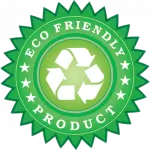Organic Wall and Ceiling Finishes for Bathrooms
When it comes to selecting a premium wall finish for bathrooms, showers, or interiors with a luxurious touch, Tadelakt and Microcement are two of the most sought-after plaster systems. While both offer seamless, waterproof finishes and modern aesthetics, they differ significantly in their style, application, and feel. Here’s everything you need to know to choose the right one for your space.
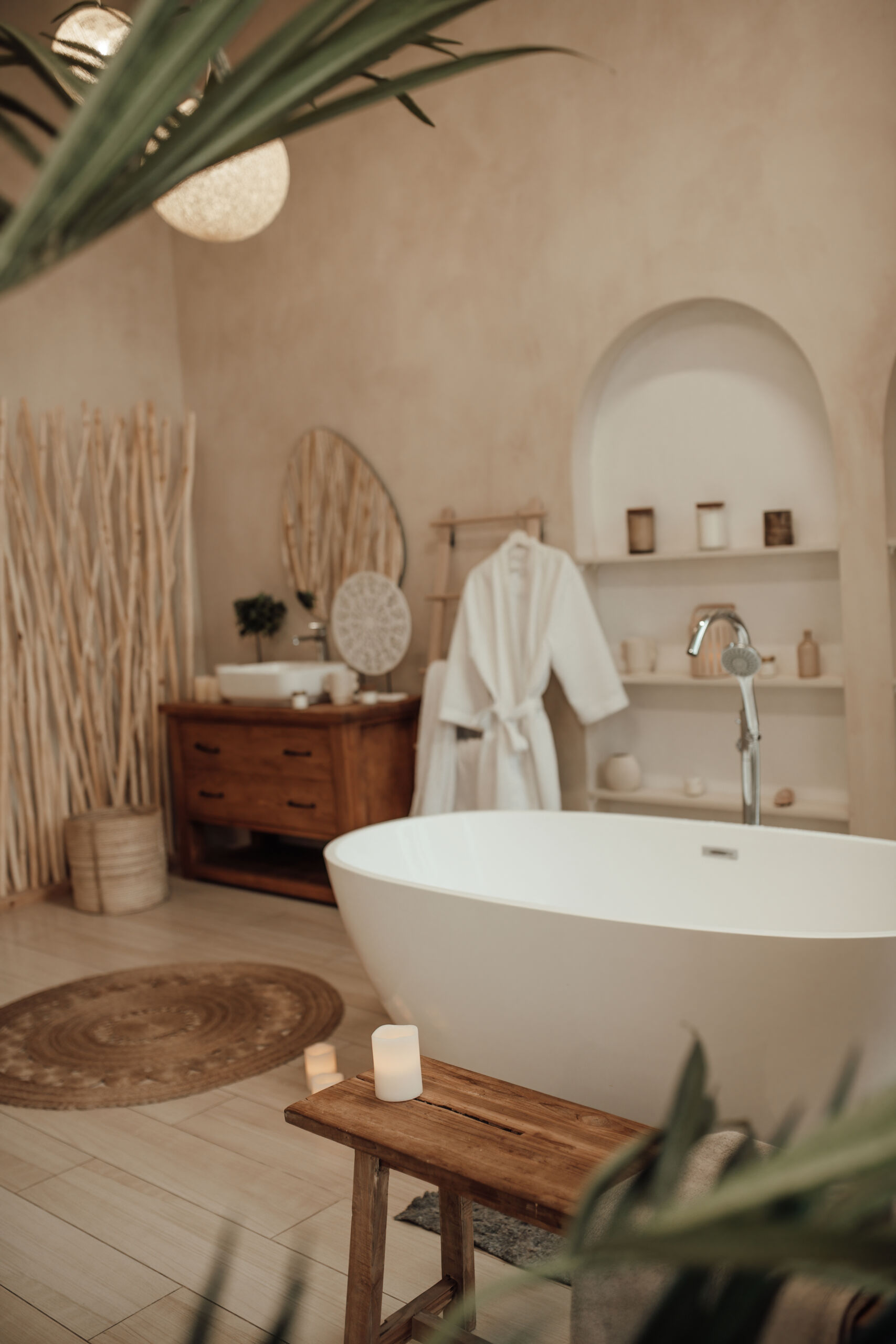
Speak To Shayan 416 (606) 8060 or Request A Quote
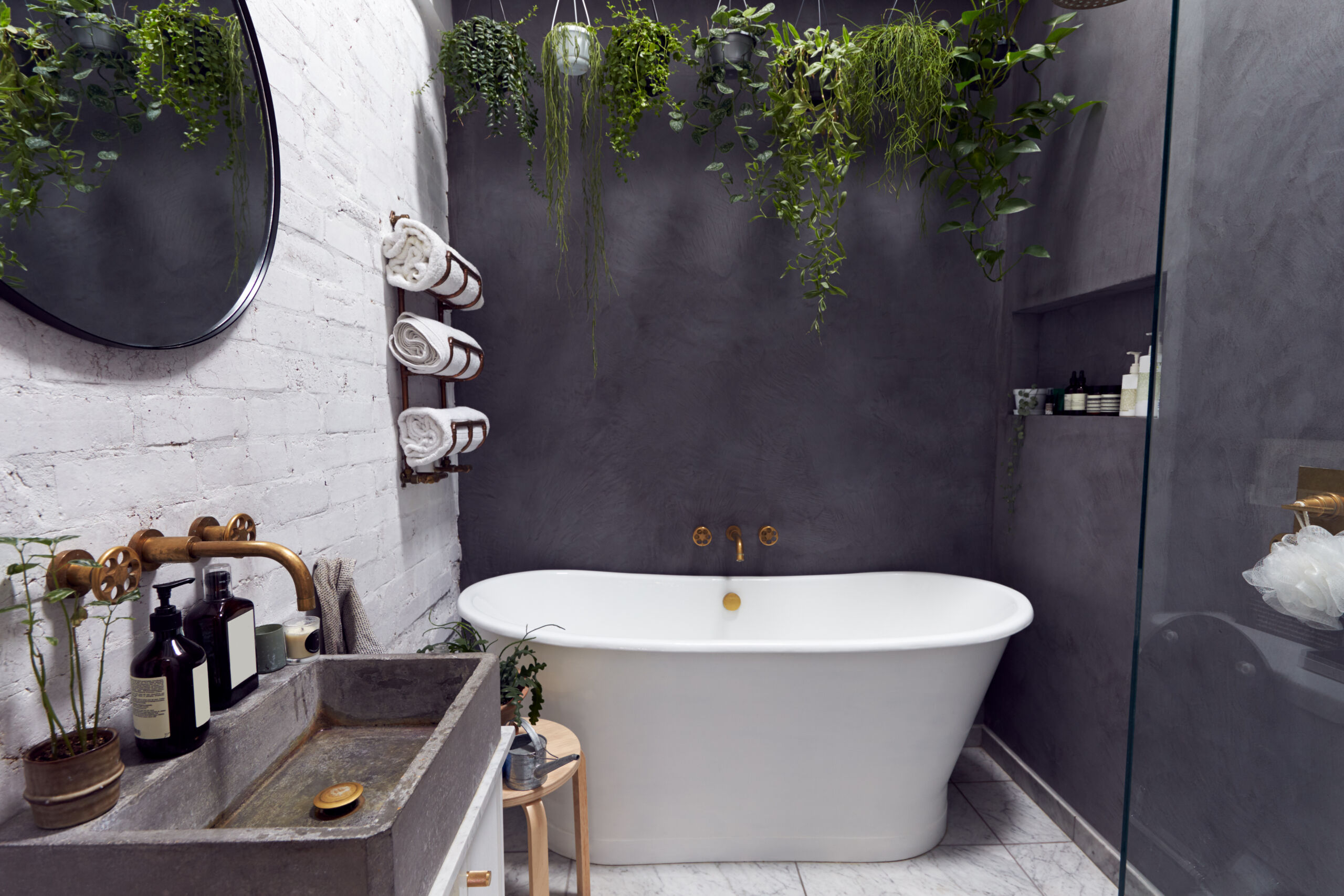
Charcoal microcement walls in a modern rustic bathroom.
Aesthetic Differences: Organic vs Modern
Tadelakt: Soft, Earthy, Timeless
Tadelakt is an ancient Moroccan plaster technique made from natural lime, polished with stones and sealed with olive soap. It results in a buttery-smooth, slightly undulating surface with a soft sheen.
Characteristics of Tadelakt:
- 100% natural and eco-friendly
- Rich, organic feel with subtle color movement
- Slightly absorbent until sealed (sealed with soap, not synthetic sealers)
- Best suited for walls, niches, and curved surfaces
- Adds a warm, earthy character to bathrooms
Tadelakt is known for its soft, velvety appearance, subtle movement, and natural sheen. The finish feels organic, aged, and artisanal, with gentle imperfections and rich tactile depth. It’s often chosen for:
- Curved niches
- Wet rooms and hammams
- Powder rooms with character
- Clients seeking a handcrafted, natural feel
Style: Tadelakt is ideal for organic modern, wabi-sabi, boho, and desert-inspired interiors.
To learn more about our tadelakt application process and the costs associated, refer to our tadelakt service page.
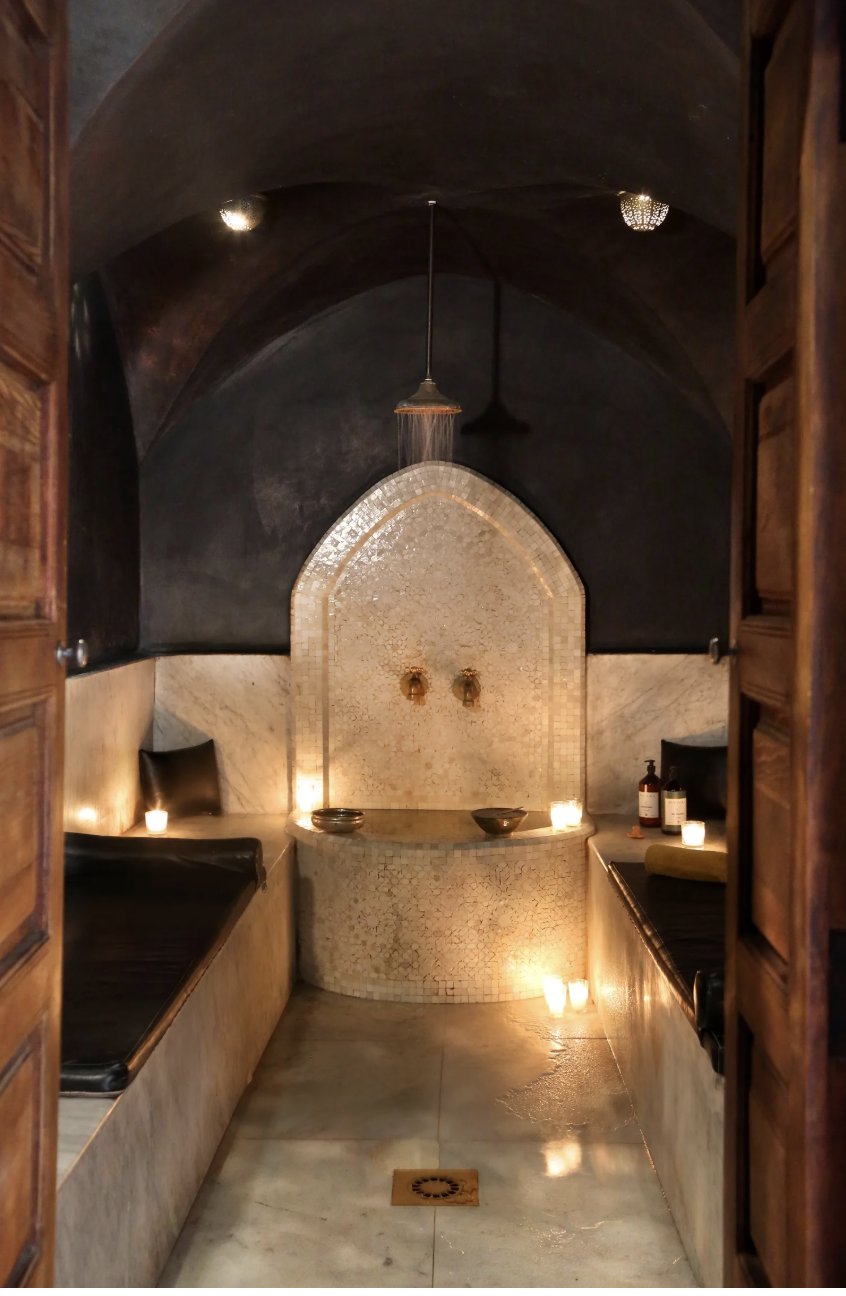
Boho-chic spa room with charcoal tadelakt walls at El Fenn spa and pools.
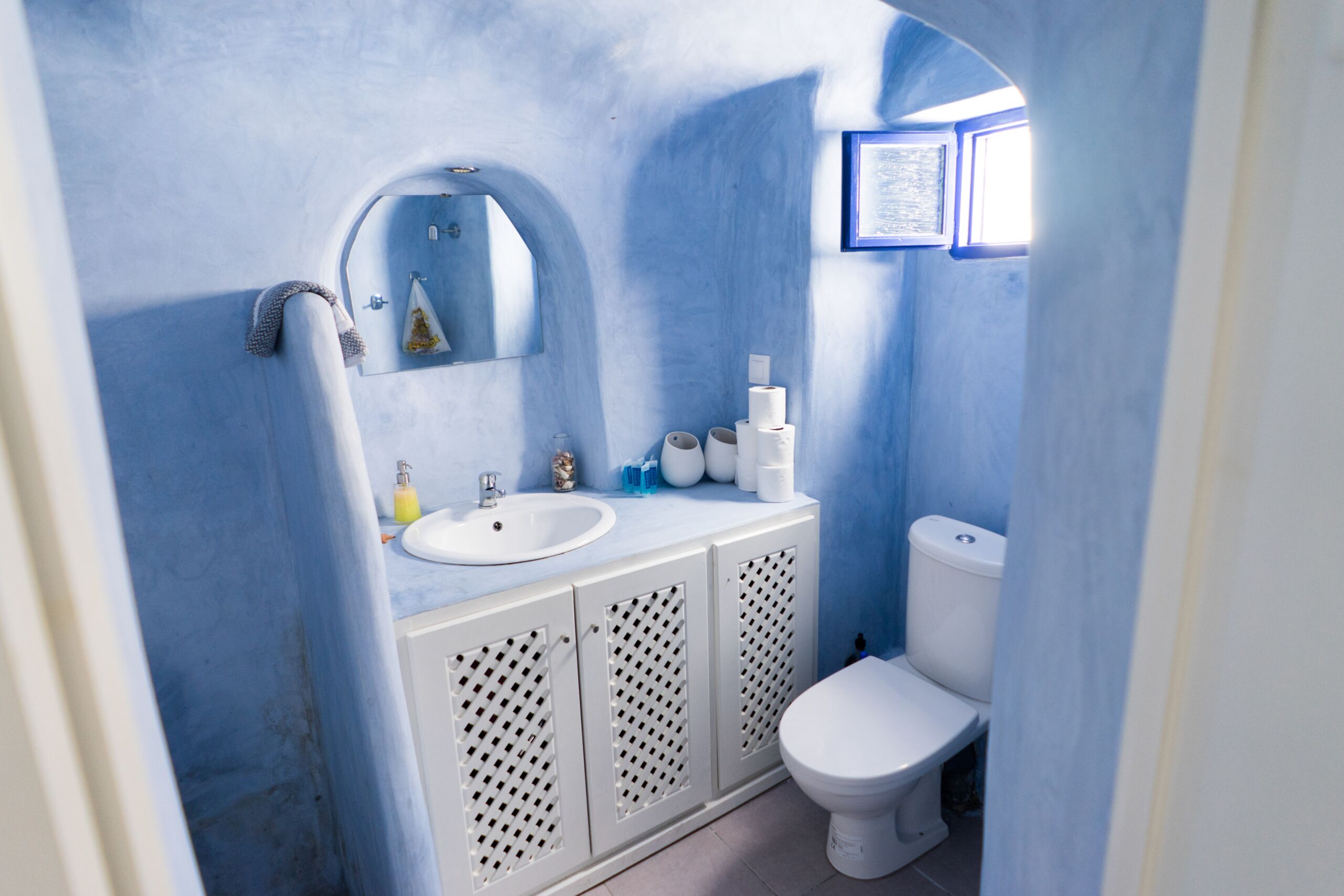
Boho-chic living room with two-toned warm beige plaster walls and macramé, a soft take on rustic plaster interiors.
Microcement: Sleek, Modern, Durable
Microcement, also known as microconcrete, is a cement-based coating mixed with polymers, applied in thin layers over existing surfaces and creating a contemporary, matte or satin finish. It has a smoother, harder feel than Tadelakt, and is incredibly versatile.
Characteristics of Microcement:
- Durable and waterproof with synthetic sealers
- Sleek, modern appearance
- Suitable for walls, floors, vanities, and wet zones like showers
- Often used in commercial bathrooms and minimalist homes
Microcement delivers a sleek, industrial aesthetic. Microcement is great for:
- Seamless floors and large walls
- Minimalist bathrooms
- Countertops and kitchens
- Commercial spaces or high-traffic areas
Style: Microcement leans more modern, industrial, and coastal minimalist.
To learn more about our microcement application process and the costs associated, refer to our microcement service page.
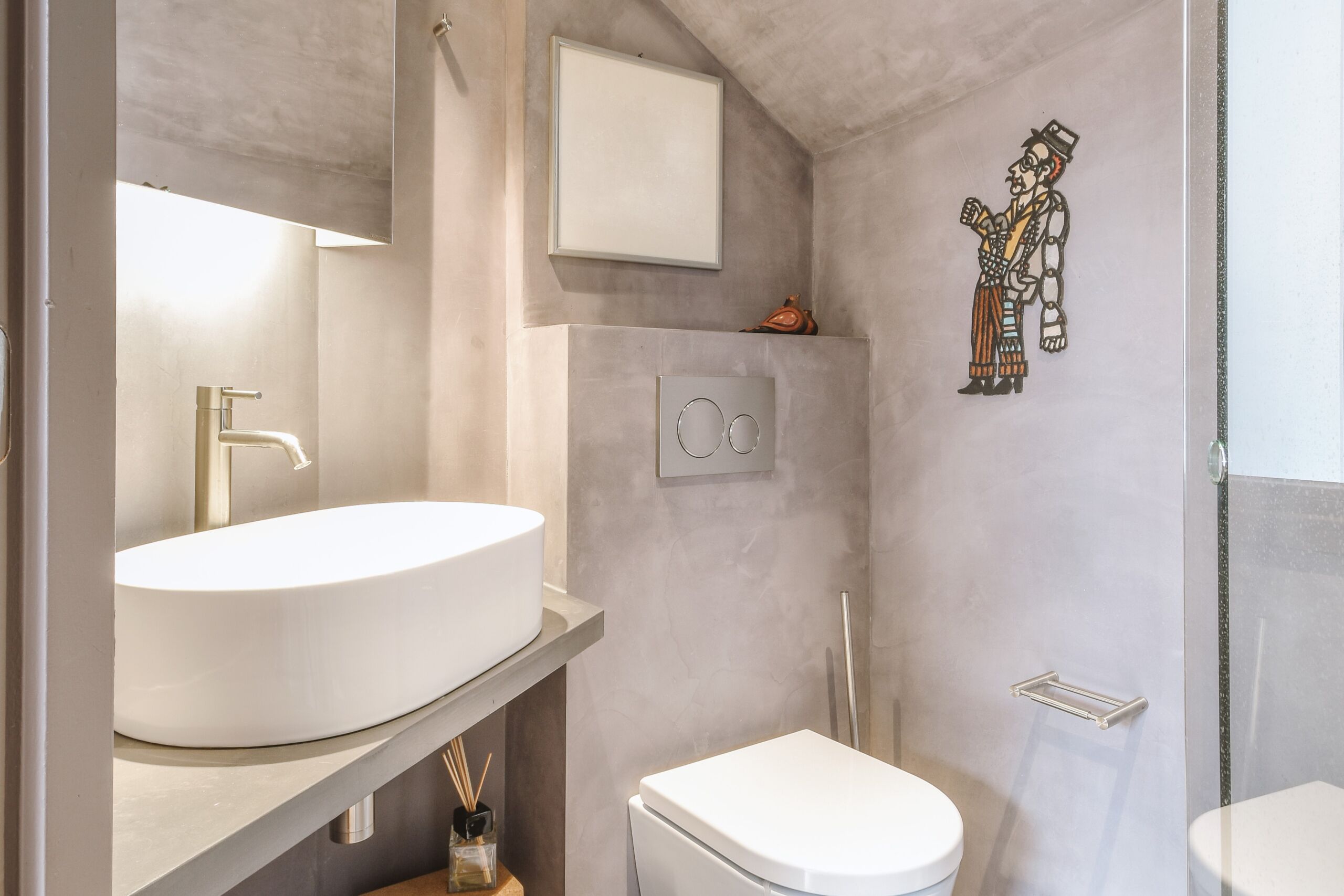
Boho-chic living room with two-toned warm beige plaster walls and macramé, a soft take on rustic plaster interiors.
Tadelakt vs Microcement – Key Differences
| Feature | Tadelakt | Microcement |
|---|---|---|
| Material Base | Lime-based natural plaster | Cement + polymer mixture |
| Texture | Soft, organic, slightly matte sheen | Smooth, even, can range from matte to satin |
| Waterproofing | Achieved with natural soap seal | Achieved with synthetic sealers |
| Application Areas | Best for walls, curved surfaces, niches | Walls, floors, counters, showers |
| Aesthetic | Rustic, earthy, handcrafted | Modern, sleek, industrial |
| Installation | Labour-intensive, highly artisanal | Easier, more flexible, multi-layer |
| Maintenance | Needs reapplication of soap over time | Easier to clean and maintain |
| Thickness | 2–4 mm | 2–3 mm |
| Finish | Matte to satin, with soft sheen | Matte or satin |
| Breathability | Highly breathable | Lower breathability |
| Durability | Medium (softer, more delicate) | High (resistant to wear & impact) |
| Application Surface | Best on curved/vertical surfaces | Great on floors & verticals |
| Application Complexity | High (requires artisan skill) | Medium (multi-layered process) |
| Cure Time | Longer (up to 28 days fully cured) | Faster (7–14 days) |
Cost Comparison: Tadelakt vs Microcement
Prices vary based on location, surface area, and prep work. Here’s a general range in Toronto & Florida:
| Surface Type | Tadelakt (CAD) | Microcement (CAD) |
|---|---|---|
| Walls (per sq.ft) | $30–$45 | $20–$35 |
| Showers | $3,800–$7,500 | $3,800–$6,500 |
| Floors | Not recommended | $35-$45 per sq.ft |
Note: Tadelakt is usually more expensive due to the artisanal labour and time it takes to polish and seal the surface.
Application Process
Tadelakt is applied in multiple thin coats, polished with a stone, and finished with a natural soap that reacts with the lime to create a water-resistant barrier. The process is labour-intensive and artisanal.
Microcement involves layering base and finishing coats, sanding between each layer, and sealing the surface. It is more systematic and modern, allowing faster turnarounds and consistent finishes.
Sustainability and Natural Appeal
- Tadelakt is 100% natural, made from lime and natural pigments, making it a great choice for eco-conscious designs.
- Microcement often includes polymers and resins but is VOC-free and low waste. Newer formulations are also becoming more sustainable.
Best Use Cases
Tadelakt is ideal for:
- Moroccan or Mediterranean design styles
- Curved or rounded walls
- Niches and arches
- Luxury spa-like bathrooms
- Powder rooms and feature walls
Microcement is ideal for:
- Seamless flooring
- Contemporary bathrooms and kitchens
- Minimalist commercial interiors
- Wet areas (walls and floors)
- Budget-conscious renovations with a premium look
Pros and Cons
Tadelakt Pros:
✅ Natural and sustainable
✅ Organic, soft appearance
✅ Breathable and mold-resistant
✅ Beautiful patina over time
Tadelakt Cons:
❌ Prone to scratches and cracks if not maintained
❌ Needs expert application
❌ Longer cure time
Microcement Pros:
✅ Durable and impact-resistant
✅ Quick to apply and cure
✅ Modern and uniform look
✅ Available in many textures and colours
Microcement Cons:
❌ Less breathable
❌ May feel colder/harsher
❌ Slightly less “natural” look
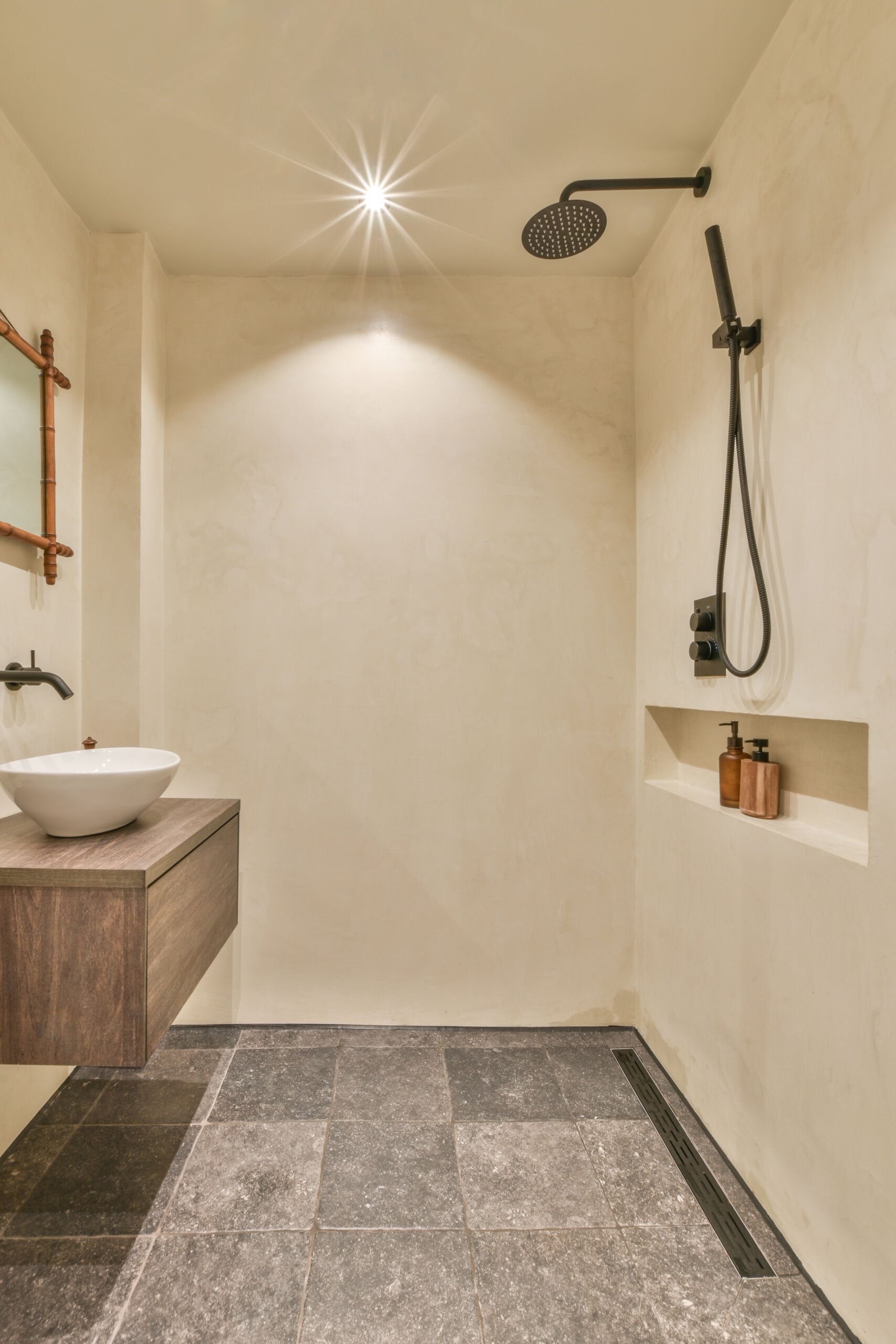
Soft off-white plastered bathroom walls in a Florida home — a clean, organic detail in modern plaster interiors.
FAQ: Tadelakt vs. Microcement bathroom
Tadelakt or Microcement for Wet Rooms & Saunas?
Choosing the Right Finish for Moisture-Heavy Spaces
When designing wet rooms, saunas, steam rooms, or luxury spa bathrooms, both Tadelakt and Microcement offer seamless, waterproof surfaces that go beyond functionality — they deliver distinct sensory and visual experiences.
Tadelakt: Organic, Timeless, Hammam-Style Feel
Tadelakt the lime-based Moroccan plaster, traditionally has been used in bathhouses. Its finish is slightly undulating, with a natural softness and sheen that feels warm and tactile to the touch.
In saunas and spa bathrooms, Tadelakt creates a serene, wabi-sabi ambiance with a timeworn elegance — ideal for those seeking an earthy, organic feel.
Texture: Silky smooth, slightly curved
Moisture Resistance: High (when properly sealed with olive soap)
Feel: Soft, meditative, spa-like
Best For: Hammam-inspired wet rooms, luxury shower niches, wellness-focused interiors
Microcement: Sleek, Modern Spa-Like Performance
Microcement the cement-based coating system reinforced with resins, is ultra-durable and flexible — perfect for high-humidity environments and contemporary wet rooms.
It has a sleek, matte or satin finish with minimal texture and pairs well with modern fixtures and clean lines.
Texture: Smooth and cool
Moisture Resistance: Very High (sealed with waterproof resin)
Feel: Crisp, minimal, modern
Best For: Steam showers, saunas, high-traffic spa zones, minimal design
Which Should You Choose? Microcement vs Tadelakt bathroom
Both finishes offer seamless, waterproof beauty — but your choice will depend on your vision.
Choose Tadelakt if you want an organic, handmade feel, timeless beauty, and don’t mind the higher price and maintenance.
Choose Microcement if you need modern minimalism, flexible application, and long-lasting performance with less upkeep.
Serving clients in Toronto, Jacksonville, and beyond!
Book a consultation session to explore our curated plaster and microcement samples.
Contact us today to get started with your bathroom transformation.
Serving Toronto (Forest Hill, Yorkville, Rosedale, Kleinburg) and Florida (Jacksonville, Miami, Naples, Tampa)
In the neighborhoods west of Toronto—such as Woodbridge, Kleinburg, Mono, and Orangeville—where custom homes and house renovations are flourishing, the design style beautifully balances warm wood elements with smooth plaster finishes. These homes blend natural textures to create inviting, cozy spaces that embrace organic charm while staying fresh and contemporary.
Meanwhile, in Florida, our work adapts to the coastal lifestyle. Timeless interiors there often feature plaster walls in earthy, sun-washed tones. This creates a light, breezy take on organic style that fits perfectly in Florida showers, bathroom, and saunas—bringing warmth and texture without feeling heavy.
Wherever you are—from Toronto’s growing custom home communities to Florida’s coastal retreats—our artisans bring local sensibility and expert craftsmanship to every project.
Serving Toronto, Los Angeles, Florida and Texas
| Toronto & GTA | |
|---|---|
|
|
| Jacksonville | Tampa | Miami | Broward County | Palm Beach County |
|---|---|---|---|---|
|
|
|
|
|
| Los Angeles | Sacramento | Long Beach | Santa Monica | Mission Viejo |
|---|---|---|---|---|
|
|
|
|
|
| Dallas | Houston | Austin | San Antonio | Fort Worth |
|---|---|---|---|---|
|
|
|
|
|



